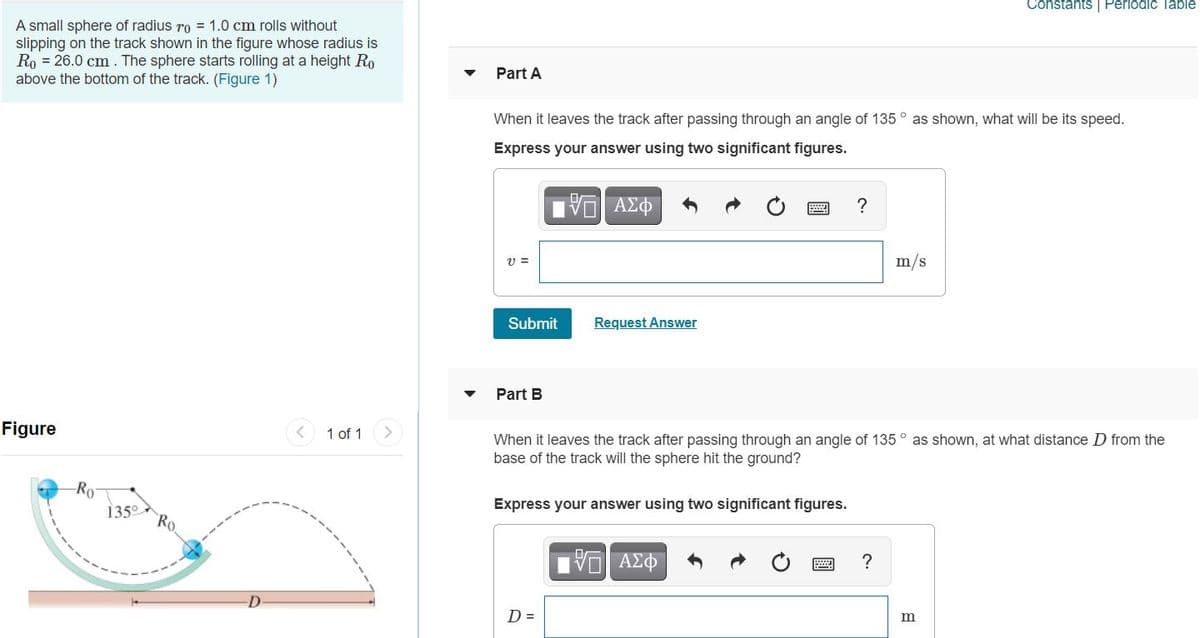A small sphere of radius ro = 1.0 cm rolls without slipping on the track shown in the figure whose radius is Ro = 26.0 cm . The sphere starts rolling at a height Ro above the bottom of the track. (Figure 1) Part A When it leaves the track after passing through an angle of 135° as shown, what will be its speed. Express your answer using two significant figures. ? m/s Submit Request Answer Part B Figure 1 of 1 When it leaves the track after passing through an angle of 135 ° as shown, at what distance D from the base of the track will the sphere hit the ground? Ro Express your answer using two significant figures. 135 Ro D D = m.
A small sphere of radius ro = 1.0 cm rolls without slipping on the track shown in the figure whose radius is Ro = 26.0 cm . The sphere starts rolling at a height Ro above the bottom of the track. (Figure 1) Part A When it leaves the track after passing through an angle of 135° as shown, what will be its speed. Express your answer using two significant figures. ? m/s Submit Request Answer Part B Figure 1 of 1 When it leaves the track after passing through an angle of 135 ° as shown, at what distance D from the base of the track will the sphere hit the ground? Ro Express your answer using two significant figures. 135 Ro D D = m.
Classical Dynamics of Particles and Systems
5th Edition
ISBN:9780534408961
Author:Stephen T. Thornton, Jerry B. Marion
Publisher:Stephen T. Thornton, Jerry B. Marion
Chapter7: Hamilton's Principle-lagrangian And Hamiltonian Dynamics
Section: Chapter Questions
Problem 7.11P
Related questions
Question
A small sphere of radius r0 = 1.0 cm rolls without slipping on the track shown in the figure whose radius is R0 = 26.0 cm. The sphere starts rolling at a height R0 above the bottom of the track.

Transcribed Image Text:Constants | Periodic Table
A small sphere of radius ro = 1.0 cm rolls without
slipping on the track shown in the figure whose radius is
Ro = 26.0 cm . The sphere starts rolling at a height Ro
above the bottom of the track. (Figure 1)
Part A
When it leaves the track after passing through an angle of 135° as shown, what will be its speed.
Express your answer using two significant figures.
ΑΣΦ
?
m/s
Submit
Request Answer
Part B
Figure
1 of 1
When it leaves the track after passing through an angle of 135° as shown, at what distance D from the
base of the track will the sphere hit the ground?
Ro
Express your answer using two significant figures.
135°
Ro
D.
D =
m
Expert Solution
This question has been solved!
Explore an expertly crafted, step-by-step solution for a thorough understanding of key concepts.
This is a popular solution!
Trending now
This is a popular solution!
Step by step
Solved in 4 steps

Knowledge Booster
Learn more about
Need a deep-dive on the concept behind this application? Look no further. Learn more about this topic, physics and related others by exploring similar questions and additional content below.Recommended textbooks for you

Classical Dynamics of Particles and Systems
Physics
ISBN:
9780534408961
Author:
Stephen T. Thornton, Jerry B. Marion
Publisher:
Cengage Learning

Principles of Physics: A Calculus-Based Text
Physics
ISBN:
9781133104261
Author:
Raymond A. Serway, John W. Jewett
Publisher:
Cengage Learning

Physics for Scientists and Engineers
Physics
ISBN:
9781337553278
Author:
Raymond A. Serway, John W. Jewett
Publisher:
Cengage Learning

Classical Dynamics of Particles and Systems
Physics
ISBN:
9780534408961
Author:
Stephen T. Thornton, Jerry B. Marion
Publisher:
Cengage Learning

Principles of Physics: A Calculus-Based Text
Physics
ISBN:
9781133104261
Author:
Raymond A. Serway, John W. Jewett
Publisher:
Cengage Learning

Physics for Scientists and Engineers
Physics
ISBN:
9781337553278
Author:
Raymond A. Serway, John W. Jewett
Publisher:
Cengage Learning

Physics for Scientists and Engineers with Modern …
Physics
ISBN:
9781337553292
Author:
Raymond A. Serway, John W. Jewett
Publisher:
Cengage Learning


Physics for Scientists and Engineers: Foundations…
Physics
ISBN:
9781133939146
Author:
Katz, Debora M.
Publisher:
Cengage Learning